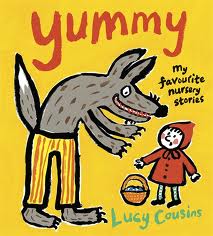Yummy by Lucy Cousins
Food is central to our lives, our pleasures, and apparently our fairy tales! In Yummy: Eight Favorite Fairy Tales, Lucy Cousins’ lends her cheerful, bold artistry to traditional stories that, upon further reflection, do indeed focus on food. She vividly depicts food that is savored and gobbled, well earned and stolen, vegetarian and fully carnivorous. Meals serve as a celebration of moral instruction (e.g., The Little Red Hen does not share the fruit of her labors with her lazy friends) and the triumph of good characters over villains (e.g., the Bremen Town Musicians vanquish the robbers).
Four of the eight tales feature some degree of peril and Cousins never sanitizes the predation and menace of these time-honored fairy tales. Disney’s Little Mermaid might have escaped the sea foam fate of Anderson’s original plot but Cousins does not spare two of the Three Little Pigs from the jaws of a voracious wolf. Although her art and spare text gear her book towards younger children, Cousins does not shy away from the original sad fates of her traditional characters. “Hee hee hee” reads the banner across the top of the page as “CRUNCH! MUNCH! Foxy Woxy gobbled up Goosey Poosey” and friends in the tale of “Henny Penny.” Happily, the chicken heroine escapes the fate of her friends as she runs home as fast as she can. Her text is simple, rhythmic, and accessible for preschoolers and young elementary students.
Cousins is fearless in her retelling of these tales. In "Little Red Riding Hood," is the wolf smiling gleefully as he swallows Grandmother whole? Why, yes, indeed he is. In Cousins’ painting, Grandmother’s feet and nightdress protrude prominently from the wolf’s smiling mouth and the artist adds “gulp!” in large black font next to the victim’s splayed white toes. A few pages later, she repeats this graphic technique, embellishing the wolf’s decapitation with the bold proclamation of “chop!” The wolf’s death is portrayed as bloodless but it is still a jolt to see an axe hovering above the wolf’s body while Little Red Riding Hood and her grandmother celebrate on the opposite page beneath the wolf’s flying head.
According to Barnes and Noble and Amazon, British author-illustrator Lucy Cousins has published more than 300 books. Her Maisy the Mouse series is ubiquitous on preschool bookshelves and in family libraries. Personally, I have never been an avid fan of Cousins’ art. While I am drawn to her bold palette and joyful tone, I have not been attracted to her simplistic black outlines and primitive style. However in this particular book, Yummy‘s charming and childishly-rendered art seems to lower the emotional load of these clearly gruesome stories. Cousins repackages the often-fearful villains in a vibrant, colorful, and naïve manner. In so doing, she successfully declaws these villains and focuses on the fantasy aspect of the story and the ultimate triumph of the heroes and heroines. Hungry wolves eventually end up in the stewpot and Goldilocks finally leaves the Three Bears to enjoy their porridge in peace. The stories always end well for the main characters.
Parents of young Maisy fans might find Yummy to be a palatable means to introduce their young children to traditional fairy tales. Turnips, porridge, and even a huffing-puffing wolf are all served up in this tasty collection of stories. Dig in!


I am having trouble reconciling the whimsical style with the morbid content. It seems like it would be so jarring. I would have to read the stories myself before deciding to present them to students. I wonder if there is anything to gain from showing the students the original sad "fates" of some of these story characters?
ReplyDeleteI am also a bit confused. In the beginning of your post, it seems that Yummy is a collection of scary, Grimm's-like fairy tales, not something directed towards preschoolers. Some preschoolers might even think that Cousins' literal portrayal of traditional fairy-tales as funny, not dark and scary.
ReplyDeleteI agree that there is certainly a disconnect. The art and the short simple prose are definitely for preschoolers but is the content appropriate? It is unsanitized, direct, and does indeed feature a disembodied flying wolf's head as well as other perhaps frightening imagery. So, what's the call? As a parent, I prefer the original stories and think these images might lessen the fear for my own kids. As a teacher, I would not be so brave.
ReplyDeleteI actually really like Cousins art. I think that it's simplicity is attractive to young readers and the bright colors draw them in. Growing up, I never really had a problem hearing stories like "Little Red Riding Hood" and the eating of the grandmother and wolf. As a child, I didn't know that there was the option of the grandmother not being eaten or the wolf not being stewed. However, I can see that there may be some hesitation on the part of us as teachers to read this to our students if parents have a problem with this kind of story.
ReplyDelete